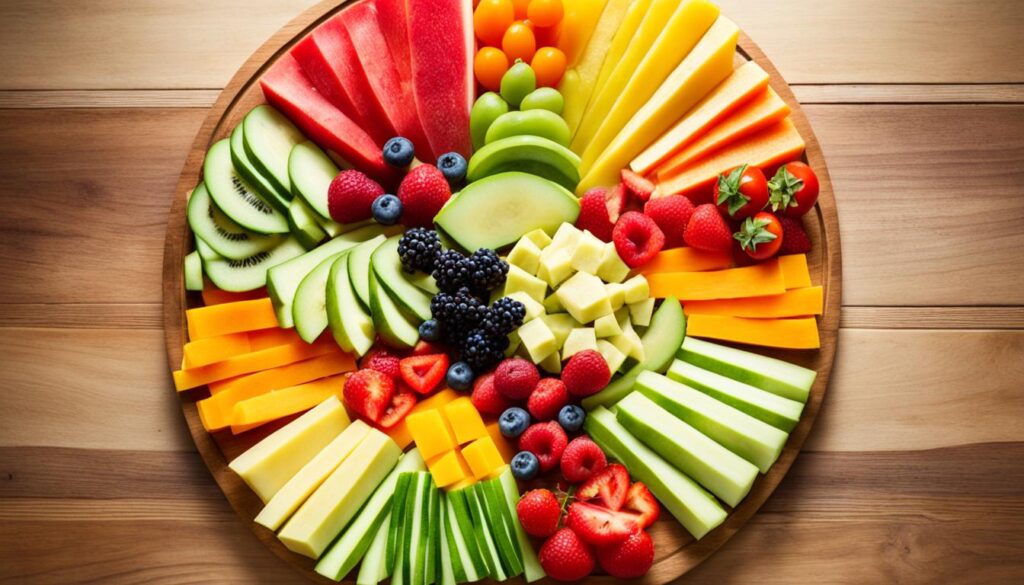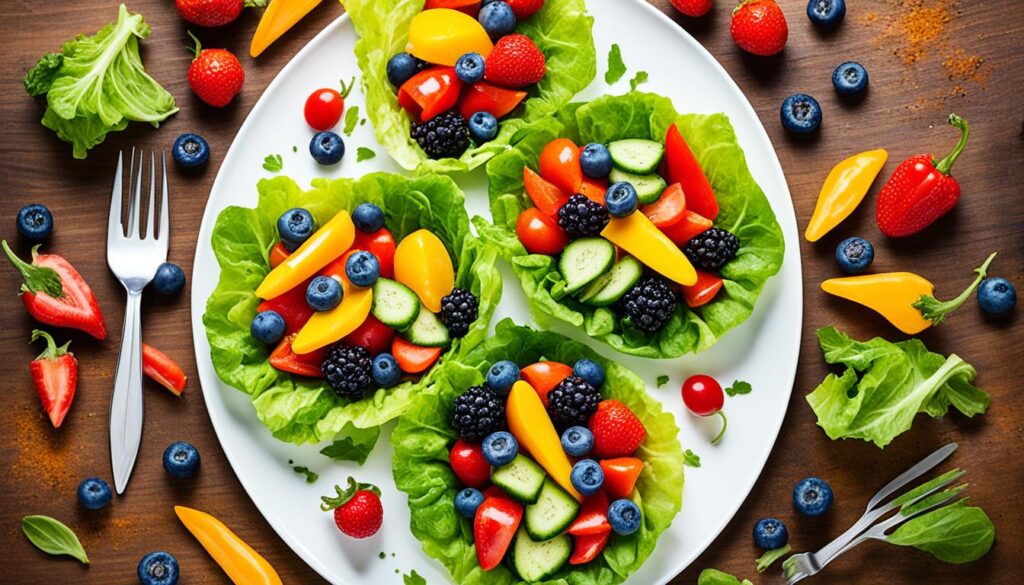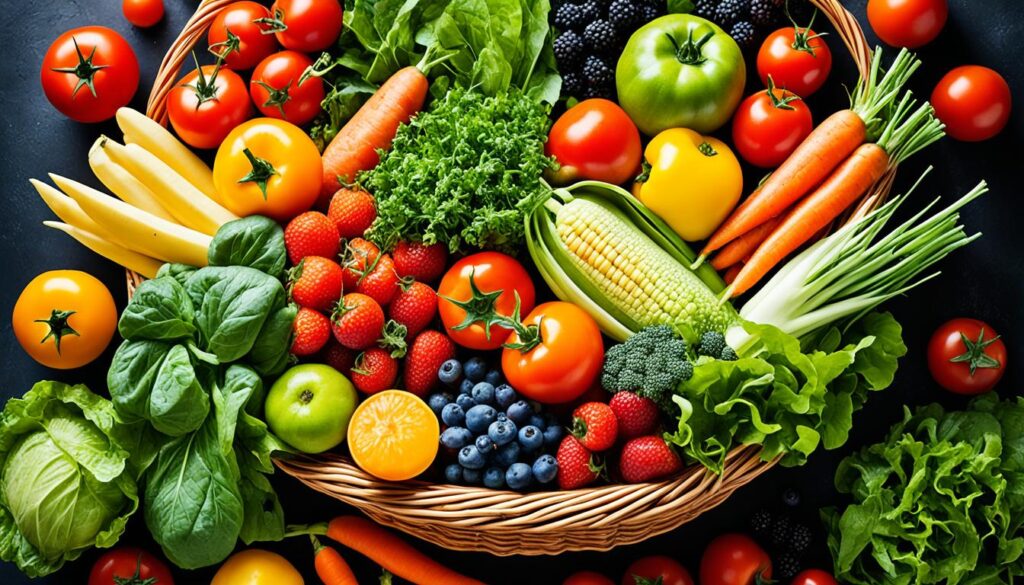Are you struggling to incorporate more fresh produce into your diet? You’re not alone1. Only about 12% of adults meet their Fruits and Veggies recommendation, and less than 10% meet their vegetable recommendations1. But what if there was a simple way to boost your health and feel great? The secret lies in making fruits and vegetables a delicious and easy-to-enjoy part of your daily routine.
Key Takeaways
- Aim for 2 cups of fruit and 2 1/2 cups of vegetables per day2
- Make half your plate fruits and vegetables for a balanced, healthy diet2
- Discover 20 ways to enjoy more fruits and vegetables daily2
- Incorporate veggies into omelets, sandwiches, tacos, and salads2
- Snack on cut vegetables, whole fruit, and fruit sauces2
Why Fruits and Vegetables Are Essential
Fruits and vegetables are essential components of a healthy diet, packed with a wide array of vital nutrients and powerful antioxidants that can support our overall well-being3. These nutrient-dense foods can play a crucial role in preventing chronic illnesses, such as obesity, heart disease, diabetes, and certain types of cancer3.
Packed with Vital Nutrients and Antioxidants
Fruits and vegetables are excellent sources of essential vitamins, minerals, and fiber that our bodies need to function at their best. For instance, avocados, sweet potatoes, bananas, prunes, and tomato paste puree are all rich in potassium3, while fiber-rich vegetables like artichokes, green peas, broccoli, and cauliflower can help fill us up and support gut health3. Additionally, the phytochemicals found in many fruits and vegetables have been linked to reduced risks of various chronic illnesses, including type 2 diabetes, stroke, heart disease, high blood pressure, and cancer3.
Support Healthy Development and Fight Chronic Illnesses
Incorporating a diverse array of colorful fruits and vegetables into our diets can provide a wide range of essential nutrients that are crucial for maintaining good health3. In fact, studies have shown that consuming fruits and vegetables can aid in lowering inflammation, cholesterol levels, and blood pressure, thanks to their low saturated fat, salt, and sugar content3. Furthermore, certain vegetables like broccoli, cabbage, collards, and watercress have been specifically linked to reducing cancer risks3.
Regardless of whether they are fresh, frozen, canned, or dried, fruits and vegetables are a convenient and nutritious addition to any diet3. In fact, research indicates that there is little nutritional difference between different forms of produce, as most processing methods are designed to preserve the essential nutrients3. With their low calorie and fat content, fruits and vegetables can be an excellent way to stay full and satisfied without consuming excess calories3.
Incorporating more fruits and vegetables into your diet is a simple yet effective way to boost your overall health and well-being. By prioritizing these nutrient-rich foods, you can take a colorful step towards a healthier future345.
The Benefits of a Balanced Diet with Fruits and Veggies
Incorporating a diverse array of fruits and vegetables into your diet can yield remarkable health benefits. Studies have shown that consuming five servings of most fruits and vegetables (excluding starchy vegetables and fruit juices) per day is associated with lower mortality rates6. These nutrient-dense foods are commonly rich in a variety of vitamins, minerals, and antioxidants that support healthy development and fight against chronic diseases like heart disease, cancer, and respiratory illness6.
The health benefits of a produce-rich diet extend far beyond reduced disease risk. Research has also linked higher fruit and vegetable consumption to improved mental well-being6. A Canadian national survey found an association between mental health disorders and fruit and vegetable consumption, underscoring the importance of a balanced diet for overall health and longevity6.
| Recommended Servings | Actual Consumption |
|---|---|
| 4.5 servings of fruits and vegetables per day7 | Approximately 2 servings per day for most Americans7 |
The American Heart Association recommends that most adults should aim for 4 servings of fruit per day and 5 servings of vegetables per day8. However, studies show that the actual consumption of fruits and vegetables among Americans falls short of these recommendations, with the average person consuming only about 2 servings per day7.
By making a conscious effort to incorporate more fruits and vegetables into your daily routine, you can unlock a wealth of health benefits and move closer to a balanced, nutritious diet.
How to Incorporate More Fruits and Vegetables into Your Diet
Incorporating more fruits and vegetables into your daily meals and snacks is an easy and delicious way to boost your health. One key tip is to make sure that fruits and veggies make up half of every meal, whether it’s breakfast, lunch, or dinner9. This helps ensure you’re getting the recommended 4.5 cups per day9.
Make Them Half of Every Meal
Suggestions include incorporating fruits like bananas, berries, and melons into breakfast for a healthy start9. For lunch, load up sandwiches and wraps with vegetables or enjoy a cup of vegetable soup9. Quick dinner options include adding canned or frozen veggies as a side dish or preparing a sweet potato with healthy toppings9. The key is to fill half of each plate with a variety of colorful fruits and vegetables at every meal9.
Snack on Dried Fruit in Moderation
Dried fruit can also be a convenient snack, but portions should be monitored as it is higher in sugar and calories than fresh fruit9. Looking for canned or frozen options with no added sugars or sodium is also a good idea9. Other healthy snacking tips involve consuming fruits like apples, oranges, and vegetables like baby carrots for a nutritional boost9.
Incorporating more fruits and vegetables into your diet is an easy way to improve your overall health and well-being. By making them half of every meal and snacking on them in moderation, you can enjoy the countless benefits these nutrient-dense foods have to offer91011.
Keep Fresh Fruit Visible and Accessible
Making fresh, nutritious produce easily accessible can be a simple yet effective way to promote healthier snacking habits. By keeping a bowl of colorful fruit on the kitchen counter or table, you make it more tempting and convenient to reach for a healthy snack12. The same principle applies to certain vegetables that don’t require refrigeration, like cherry tomatoes or baby carrots – placing them in a readily visible spot encourages their consumption12.
Numerous studies have highlighted the importance of making fruits and vegetables more accessible to increase their intake12. Nutrition experts recommend aiming for at least 5 servings of fruits and vegetables per day, which can be easily achieved by incorporating them into each meal or snack12. With many individuals eating around 5 times a day, having produce readily available creates an opportunity to easily meet this dietary target12.
For families, making fruits and vegetables visible and accessible can be particularly impactful12. Repeated exposure is crucial for children’s acceptance of new foods, and involving them in the selection and preparation process can further pique their interest12. Additionally, encouraging family members to experiment with new ways of incorporating produce into meals can help combat food ruts and promote a wider variety of fruits and vegetables in the diet12.
Beyond fresh produce, keeping frozen fruits and vegetables on hand can offer a convenient and long-lasting alternative to promote healthier snacking13. By making nutritious options readily available, you can effortlessly add more fruits and vegetables to your daily routine and reap the numerous health benefits they provide1314.

| Fruit/Vegetable | Serving Size | Recommended Daily Intake |
|---|---|---|
| Vegetables | 1 cup | 2 or more cups |
| Fruits | 1/2 cup | 1 1/2 or more cups |
“Keeping a bowl of fruit on the kitchen counter or table can make fruits more visible and increase consumption.”13
Load Up on Veggies in Stir-Fries
Stir-fries are an excellent way to pack in multiple servings of vegetables in a single dish. The cooking process reduces the size of fresh veggies significantly, allowing you to load up on ingredients like spinach, kale, carrots, broccoli, bell peppers, and more15. In fact, a well-executed vegetable stir-fry can be prepared in just about 12.11 minutes, making it a quick and simple way to boost your vegetable intake at mealtime15.
One of the best things about stir-fries is their versatility. The recipe can be customized with a variety of aromatics, harder vegetables, and softer veggies, along with a flavorful sauce16. Popular choices for stir-fry vegetables include onions, mushrooms, bell peppers, broccoli, and snow peas16. The key is to cut all the vegetables into uniform pieces for even cooking16.
To create a delicious vegetable-rich stir-fry, start by preheating your pan or wok to get it nice and hot16. This helps ensure the vegetables cook quickly and retain their crisp texture. You can even prep the veggies and sauce up to 24 hours in advance for easy meal ideas15. Once the pan is hot, add a bit of peanut oil and then toss in your chopped vegetables. Stir-fry until they’re tender-crisp, then add in your sauce16.
The beauty of stir-fries is that they’re endlessly customizable. Feel free to experiment with different protein sources like chicken, beef, or shrimp to boost the nutritional value16. You can also adjust the heat level by adding a dash of sriracha or red pepper flakes16. And don’t be afraid to play with the sauce – a simple soy-based sauce works great, or you can switch it up with a teriyaki or Thai-inspired flavor16.
Whether you’re serving your veggie-rich stir-fry over noodles or rice15, it’s a fantastic way to load up on essential nutrients and antioxidants. With a little bit of prep work, you can have a delicious, healthy meal on the table in no time15.
Stir-frying is a cooking technique that originated in China and has since spread across Asia and the West17. Typical vegetables used in a vegetable stir-fry include red bell pepper, yellow bell peppers, sugar snap peas, carrots, mushrooms, broccoli, baby corn, and water chestnuts17. This cooking method helps retain more nutrients in the vegetables compared to boiling, thanks to the quick cooking process17.
When it comes to stir-frying, the key is to have all your ingredients prepped and ready to go. This ensures a smooth, efficient cooking process. And don’t forget to cut the veggies into similar-sized pieces for even cooking17. With a little practice, you’ll be whipping up delicious, vegetable-rich stir-fries in no time151617.
Explore Your Local Farmer’s Market
Visiting your local farmer’s market is a fantastic way to discover a wide array of fresh, seasonal produce. As you stroll through the vibrant stalls, you’ll be greeted by an abundance of items at their peak ripeness and flavor, from pumpkins and squash to leafy greens and juicy berries18. Exploring these farmer’s markets can inspire you to try new, in-season fruits and vegetables, adding more variety and nutritional value to your diet18.
Discover Seasonal Produce Treasures
The farmer’s market is a treasure trove of seasonal produce, offering a diverse selection that goes far beyond what you’ll find in a typical supermarket18. The USDA highlights that seasonal foods are at their peak in terms of flavor and nutritional value, with small-scale farmers often utilizing sustainable and organic farming practices18. As you browse the stalls, you’ll have the opportunity to chat with the farmers who grew the produce, learning about their growing methods and the unique qualities of each item19.
In addition to the incredible freshness and flavor, shopping at the farmer’s market also has environmental benefits19. The reduced food miles, or the distance the produce travels, leads to a smaller carbon footprint and supports the local economy by keeping more money within the community19.
Exploring the farmer’s market can also be a fun and educational experience for the whole family20. The wide variety of produce and unique products encourage culinary experimentation and promote a diverse diet, while also fostering a sense of community20.

“Purchasing local produce keeps more money in the community, contributing to the local economy.”19
So, the next time you have the chance, be sure to visit your local farmer’s market and discover the seasonal produce treasures that await18. Your taste buds and overall health will thank you!
Add Fresh Fruit to Desserts
Incorporating fresh fruit into desserts is an easy way to add more produce to your diet. Whether it’s a cobbler, cake, or yogurt parfait, topping or mixing in fresh berries, peaches, or other seasonal fruits can provide a nutritious twist on sweet treats21. The natural sweetness of fruit can also help reduce the need for added sugars21.
Selecting local and seasonal fruits and vegetables whenever possible is recommended, as they are often at their peak freshness and flavor21. When choosing fruit, look for pieces that are slightly soft, except for apples, while vegetables should be crisp and firm21. Proper storage is also key, with items like bananas, cucumbers, and potatoes best stored at room temperature, while avocados, kiwi, and pears can be kept at room temperature until ripe and then refrigerated21. Apples, berries, carrots, and dark leafy greens should be stored in the fridge21.
To inspire your fruit-based dessert creations, consider recipes like Rosemary Quick-Pickled Peaches and Blackberries, Baked Apples Stuffed with Cranberries and Walnuts, or a refreshing Creamy Avocado Dip21. By incorporating more fruit-based desserts and healthier sweets into your diet, you can enjoy the natural sweetness of produce while boosting your overall nutrient intake22.
“Fruit and vegetables are some of the most important foods for promoting good health. They are packed with vitamins, minerals, and antioxidants that can help protect against chronic diseases.”
Whether you’re craving a sweet treat or looking to add more fruits and vegetables to your routine, exploring the world of fruit-based desserts can be a delicious and22 nutritious way to do so23.
| Fruit-Based Dessert Idea | Nutrients and Benefits |
|---|---|
| Baked Apples Stuffed with Cranberries and Walnuts | Apples provide fiber, vitamin C, and antioxidants. Cranberries are a rich source of antioxidants, and walnuts offer healthy fats and protein. |
| Rosemary Quick-Pickled Peaches and Blackberries | Peaches are high in vitamin C, while blackberries contain antioxidants and fiber. The rosemary adds an aromatic, savory touch. |
| Creamy Avocado Dip | Avocado is packed with healthy monounsaturated fats, fiber, and various vitamins and minerals. It can be used as a nutritious dip or spread. |
By incorporating more fruit-based desserts and healthier sweets into your routine, you can indulge your sweet tooth while boosting your overall nutrient intake and supporting your health22. Whether you opt for a seasonal cobbler, a creamy parfait, or a savory-sweet dip, the possibilities are endless for adding more fruits and vegetables to your dessert repertoire232122.
Swap Bread for Lettuce Wraps
Swapping out traditional bread for large, crunchy lettuce leaves is a fantastic way to boost your vegetable intake and explore delicious low-carb alternatives24. Lettuce wraps can serve as the base for all your favorite sandwiches, burgers, and handheld meals, providing a nutritious and satisfying option that keeps your carb consumption in check.
One of the key benefits of lettuce wraps is their significantly lower calorie count compared to bread24. While a slice of bread can range from 80 to 150 calories, a large lettuce leaf typically contains only 5 to 15 calories, making it a much lighter and more waistline-friendly choice.
If you’re looking to take your veggie-based meals to the next level, consider experimenting with a variety of lettuce wrap fillings25. For a sturdy and crunchy base, try bell pepper sandwiches or cucumber subs. Portobello mushroom buns offer a delicious low-carb alternative, while aubergine roll-ups provide a satisfying and portable option. And for those seeking a bread-like texture, almond bread made from almond flour is a popular and nutrient-dense choice25.
Embracing lettuce wraps as a bread substitute is not only a great way to boost your vegetable intake but also a simple strategy to enjoy your favorite flavors while keeping your carb and calorie consumption in check24. Whether you’re looking to manage your weight, follow a low-carb diet, or simply eat more veggies, this versatile swap can be a game-changer in your healthy eating journey.
| Bread Alternative | Nutrient Profile |
|---|---|
| Lettuce Leaves | Low in calories, carbs, and high in fiber and vitamins24 |
| Portobello Mushroom Buns | Low-carb, provide a meaty texture, and add an extra vegetable serving25 |
| Bell Pepper Sandwiches | Sturdy, crunchy, low-carb, and add a fresh veggie boost25 |
| Cucumber Subs | Low-carb, provide crunch and bulk to the meal, great for reducing carb intake25 |
| Aubergine Roll-ups | Versatile, low-carb, and offer a satisfying vegetable-based wrap25 |
| Almond Bread | Significantly lower in carbs than wheat flour, making it a popular low-carb option25 |
By exploring these delicious and nutritious lettuce wrap alternatives, you can enjoy your favorite meals while prioritizing your health and well-being24. Get creative with your fillings, experiment with different lettuce varieties, and savor the crunchy, low-carb goodness of veggie-based wraps.

“Lettuce wraps are a game-changer for anyone looking to boost their veggie intake and cut down on carbs. They’re a simple, delicious swap that can transform your favorite meals into healthier, more satisfying options.”
So, the next time you’re craving a sandwich or burger, consider swapping the bread for a large, fresh lettuce leaf24. This simple switch can open up a world of new culinary possibilities while supporting your overall health and wellness goals.
Enjoy a Side Salad with Dinner
Adding a side salad to any meal, whether eating at home or dining out, is an easy way to boost your intake of fresh fruits and vegetables26. Get creative with your salad ingredients, mixing in a variety of colorful produce like leafy greens, crunchy vegetables, and juicy fruits. Not only does this approach increase the nutrient density of your plate, but it also introduces delightful flavor combinations that can elevate your dining experience27.
Get Creative with Fruit and Veggie Combinations
When building your side salad, don’t be afraid to experiment with unexpected pairings. Try mixing in slices of crisp apples, juicy oranges, or sweet grapes alongside your leafy greens and crunchy vegetables26. The vibrant colors and complementary flavors will not only make your salad visually appealing but also provide a satisfying and nutritious28 meal enhancement26.
To boost the overall nutritional value of your side salad, consider adding other nutrient-dense ingredients like avocado, nuts, seeds, or legumes27. These additions can transform your simple side salad into a complete and satisfying meal28.
Remember, the key to enjoying a side salad is to have fun with it. Experiment with different fruit and vegetable pairings, try new dressings and seasonings, and let your creativity shine27. By doing so, you’ll not only nourish your body but also elevate your dining experience26.
The Colorful Way to Good Health
Achieving optimal health is not just about counting calories or macronutrients – it’s about nourishing your body with a diverse array of essential vitamins, minerals, and antioxidants. The secret to a balanced diet lies in the vibrant colors of nature’s bounty: fruits and vegetables29.
Aim for a Rainbow of Produce
Experts recommend consuming up to nine servings of fruits and vegetables daily, with veggies making up the majority of your plate29. By filling at least three-quarters of your lunch and dinner plates with a variety of colorful produce, you can ensure your body is getting the nutrient diversity it craves29.
Each color group – red, orange, yellow, green, blue/purple – offers unique health benefits. For instance, red produce like tomatoes and cherries are rich in the antioxidant lycopene, which supports heart health and may reduce the risk of certain cancers30. Orange and yellow fruits and veggies, such as carrots and bananas, contain carotenoids that can lower inflammation and the risk of heart disease30.
Green produce, including leafy greens and broccoli, is a powerhouse of indoles and isothiocyanates, which may help prevent cancer30. White and brown fruits and vegetables, like onions and garlic, boast flavonoids and allicin that can reduce cholesterol and have anti-tumor properties30. Finally, blue and purple produce, such as blueberries and eggplants, are rich in anthocyanins, which are linked to improved brain health and memory function30.
Incorporating a wide variety of colorful fruits and vegetables into your diet is the key to a balanced, nutrient-dense eating plan that supports overall well-being2931.
Eating a rainbow of produce not only provides an array of essential vitamins and minerals but also helps ensure you’re getting a diverse range of beneficial plant compounds2931. By making fruits and veggies the foundation of your meals, you’ll be on your way to a healthier, more vibrant you293130.
Effortless Tips for Busy Schedules
For those with hectic lifestyles, there are simple ways to seamlessly integrate more fruits and vegetables into your daily routine32. Keeping frozen produce on hand for quick steaming or sautéing can make meal preparation a breeze32. Prepping veggie snacks like carrot sticks or grape tomatoes in advance ensures you have healthy options readily available32. Additionally, adding extra produce to recipes like soups, stews, and sauces can boost your nutrient intake without any extra effort.
Meal planning and preparation are key to quick and easy produce integration32. Prepping a week’s worth of veggies in advance can simplify the process of meal prep and convenience32. Transforming vegetables into alternative forms, such as turning cauliflower into “rice” or using sweet potato, carrot, or zucchini noodles, provides a satisfying way to enjoy more produce32.
Incorporating vegetables into your meals doesn’t have to be time-consuming32. Adding extra greens to omelets, topping toast with veggies, or baking them into baked goods can all contribute to your daily vegetable intake32. With a bit of planning and creativity, boosting your fruit and veggie consumption can be seamless, even on the busiest of schedules.
Remember, small steps can make a big difference. By incorporating these effortless tips, you can enjoy the numerous benefits of a diet rich in fruits and vegetables, even with a hectic lifestyle323334.
Conclusion
Incorporating more fruits and vegetables into your diet provides a wealth of health benefits, from supporting healthy development and fighting chronic illnesses to boosting overall healthier living35. By following the tips and strategies outlined in this article, you can effortlessly add more produce to your meals and snacks, making it easier than ever to meet the recommended daily intake of35 4 to 5 servings of fruits and vegetables per day.
Whether it’s swapping bread for lettuce wraps, packing your stir-fries with veggies, or enjoying fresh fruit for dessert, there are countless easy implementation ways to nurture your body with the power of fruits and vegetables36. Eating at least 400g of fruits and vegetables per day, as recommended by the World Health Organization (WHO), can help reduce the risks of coronary heart disease, cardiovascular disease, stroke, and premature death36. Incorporating a wide variety of produce, from apples and pears to green leafy vegetables and cruciferous veggies, can provide your body with the diverse nutrients it needs for optimal health.
By making summary of benefits fruits and vegetables a central part of your diet, you can take a significant step towards a healthier, more vibrant life. So, embrace the colorful world of produce and enjoy the many delicious and nourishing ways to fuel your body and mind.
FAQ
What are the health benefits of adding more fruits and vegetables to your diet?
According to the American Heart Association, consuming a variety of colorful fruits and vegetables can provide a wide range of health benefits, including weight management, heart disease prevention, cancer prevention, and overall healthy development.
How many servings of fruits and vegetables should I aim for per day?
The American Heart Association recommends filling half your plate with fruits and vegetables, which translates to about 4.5 cups of produce per day.
What are some of the key nutrients found in fruits and vegetables?
Fruits and vegetables are packed with essential vitamins, minerals, fiber, potassium, folate, and antioxidants that support healthy development and fight against chronic illnesses.
How can I easily incorporate more fruits and vegetables into my meals and snacks?
There are many simple strategies, such as making produce half of every meal, keeping fresh fruit visible and accessible, loading up on veggies in stir-fries, and swapping bread for lettuce wraps.
Why is it important to eat a variety of colorful fruits and vegetables?
Eating a diverse array of produce ensures you get a wide range of beneficial nutrients, as different color groups provide unique vitamins, minerals, and antioxidants that support overall health.
What are some tips for adding more fruits and vegetables to my diet, even with a busy schedule?
Keeping frozen vegetables on hand, prepping veggie snacks in advance, and adding extra produce to recipes like soups and sauces are all easy ways to boost your fruit and veggie intake, even on the busiest days.
Source Links
- 10 Ways to Eat More Fruits and Vegetables
- 20 Ways to Enjoy More Fruits and Vegetables
- Top 10 Reasons to Eat More Fruits and Vegetables
- Health Benefits of Fruits and Vegetables
- How to Eat More Fruit and Vegetables
- Fruit and Vegetable Intake: Benefits and Progress of Nutrition Education Interventions- Narrative Review Article
- 10 Ways to Get More Fruits and Veggies
- How to Eat More Fruits and Vegetables
- Tips for Eating Healthier | Eating to Reduce Cancer Risk
- 17 Creative Ways to Eat More Vegetables
- 8 Tips to Add More Fruits and Veggies to Your Diet
- 6 Ways to Add More Fruits and Vegetables to Your Diet
- Focus on Fruits and Veggies – Health Promotion
- Vegetables and Fruits
- You’ve Got to Try Ree’s Veggie Stir-Fry!
- Stir Fry Vegetables (Quick & Easy!) – Wholesome Yum
- Easiest Vegetable Stir Fry
- The Health Benefits of Supporting Local Farmers Markets – Historic Manassas, Inc
- Farmers Market Finds
- Farmers Markets Support Healthy Communities – Farmers Market Coalition
- 22 Recipes To Add Fruits And Vegetables In Your Diet | McCormick
- 25 Easy Ways to Eat More Fruits & Veggies at Every Meal
- How to eat more fruit and veg
- Try a Bread Swap Substitution
- Swap the bread for these low carb alternatives
- Simple, inexpensive ways to eat more fruit and veggies
- How to Make an Everyday Rainbow Salad
- Here’s How to Make a Salad That Will Actually Satisfy You and Keep You Full
- Eat a Colorful Diet
- Eat the rainbow for good health – Mayo Clinic News Network
- 3 Easy Ways to Eat More Vegetables | Howdy Health
- Top 9 Ways to Eat More Vegetables – Fit Men Cook
- 7 Ways to Eat More Vegetables
- Video: How to eat more veg without even noticing
- Increasing fruits and vegetables in your child’s diet
- The benefits of fruits and vegetables


